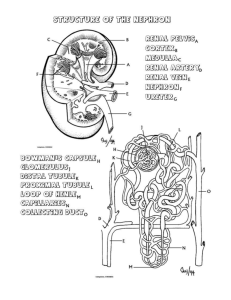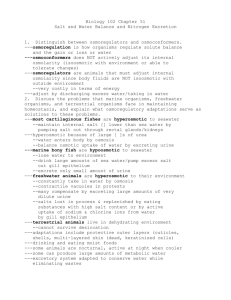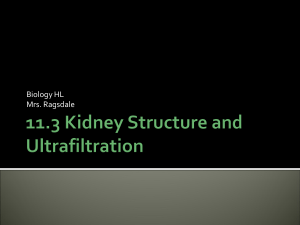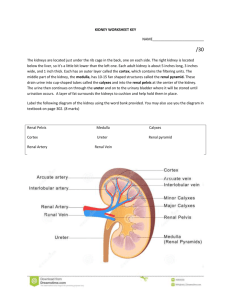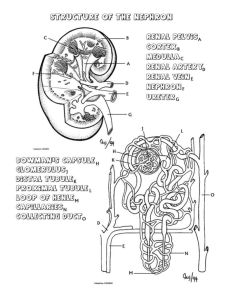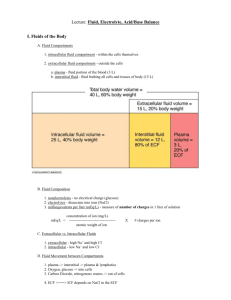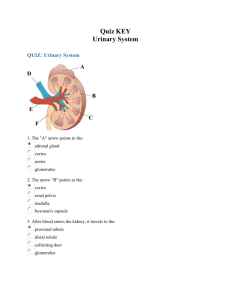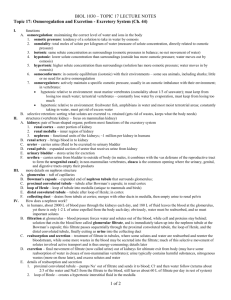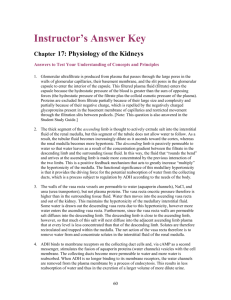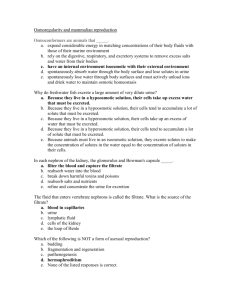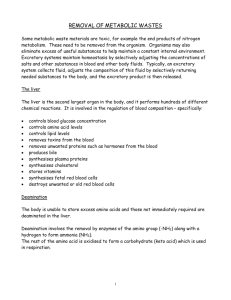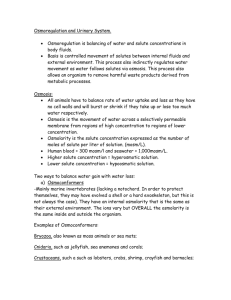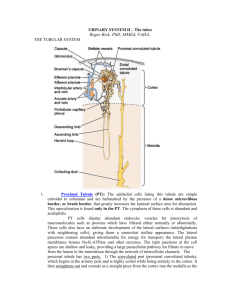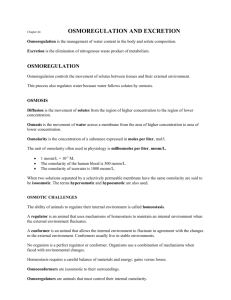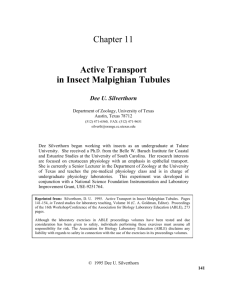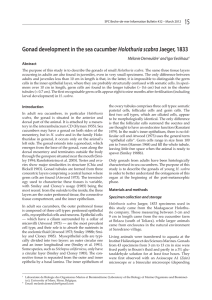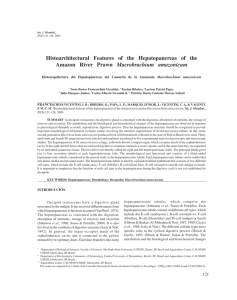Chapter 47: Osmoregulation and Disposal of Metabolic Wastes
advertisement
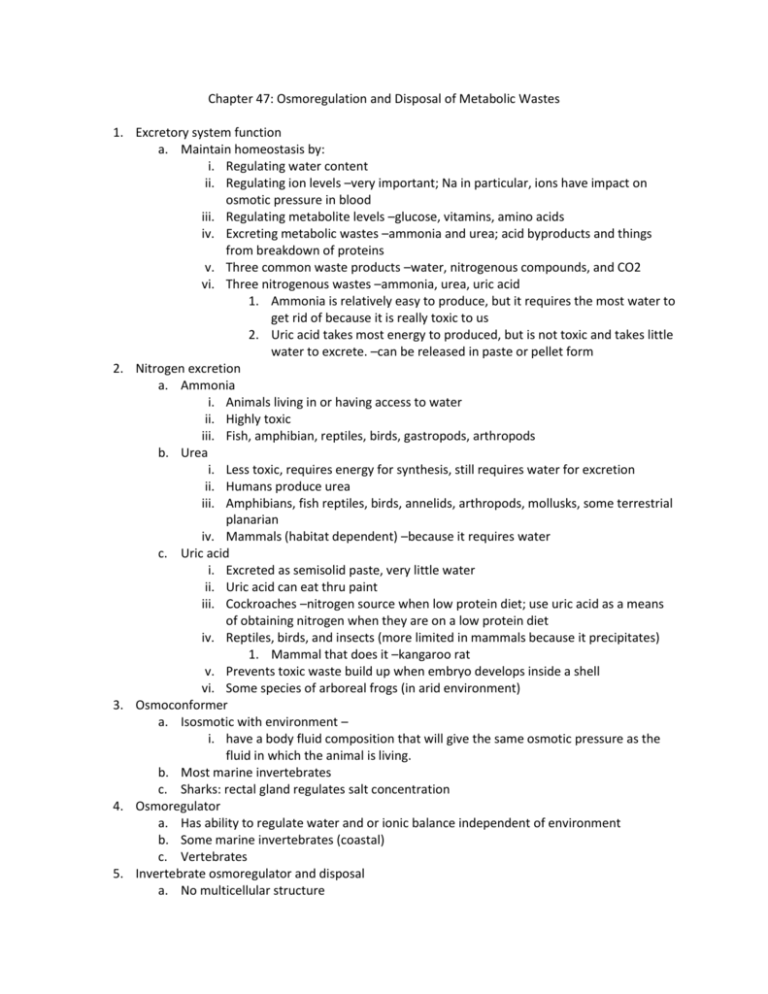
Chapter 47: Osmoregulation and Disposal of Metabolic Wastes 1. Excretory system function a. Maintain homeostasis by: i. Regulating water content ii. Regulating ion levels –very important; Na in particular, ions have impact on osmotic pressure in blood iii. Regulating metabolite levels –glucose, vitamins, amino acids iv. Excreting metabolic wastes –ammonia and urea; acid byproducts and things from breakdown of proteins v. Three common waste products –water, nitrogenous compounds, and CO2 vi. Three nitrogenous wastes –ammonia, urea, uric acid 1. Ammonia is relatively easy to produce, but it requires the most water to get rid of because it is really toxic to us 2. Uric acid takes most energy to produced, but is not toxic and takes little water to excrete. –can be released in paste or pellet form 2. Nitrogen excretion a. Ammonia i. Animals living in or having access to water ii. Highly toxic iii. Fish, amphibian, reptiles, birds, gastropods, arthropods b. Urea i. Less toxic, requires energy for synthesis, still requires water for excretion ii. Humans produce urea iii. Amphibians, fish reptiles, birds, annelids, arthropods, mollusks, some terrestrial planarian iv. Mammals (habitat dependent) –because it requires water c. Uric acid i. Excreted as semisolid paste, very little water ii. Uric acid can eat thru paint iii. Cockroaches –nitrogen source when low protein diet; use uric acid as a means of obtaining nitrogen when they are on a low protein diet iv. Reptiles, birds, and insects (more limited in mammals because it precipitates) 1. Mammal that does it –kangaroo rat v. Prevents toxic waste build up when embryo develops inside a shell vi. Some species of arboreal frogs (in arid environment) 3. Osmoconformer a. Isosmotic with environment – i. have a body fluid composition that will give the same osmotic pressure as the fluid in which the animal is living. b. Most marine invertebrates c. Sharks: rectal gland regulates salt concentration 4. Osmoregulator a. Has ability to regulate water and or ionic balance independent of environment b. Some marine invertebrates (coastal) c. Vertebrates 5. Invertebrate osmoregulator and disposal a. No multicellular structure 6. 7. 8. 9. 10. i. Protists 1. Have organelles 2. Contractile vacuoles 3. Take up water because they are hypertonic to environment ii. Nematodes 1. Specialized cells: renette cells a. Similar to contractile vacuoles 2. Tubules may be present a. Tubule connects cells and to the outside Nephridial Organs a. Help maintain homeostasis i. Regulating concentration of body fluids ii. Osmoregulation iii. Excretion of metabolic wastes Protonephridia a. Tubules with no internal openings i. in flatworm and nemerteans b. Interstitial fluid enters blind ends i. Flame cells with cilia ii. Flame cells have slits c. Cilia propel fluid through tubules d. Excess fluid exits through nephridiopores –excretory pore Metanephridia a. Tubules open at both ends i. In most annelids and mollusks b. Fluid from coelom moves through tubule i. Needed materials reabsorbed by capillaries c. Urine exits through nephridiopores d. Earthworm can take things out or put things in (reabsorb or secrete) Malpighian Tubules a. Extensions of insect gut wall i. Blind ends lie in hemocoel b. Malpighian tubules effectively conserve water c. Insects have blind ended ones i. Ions (K and Cl) and uric acid actively transported into lumen ii. Solution is hypertonic so water enters iii. Fluid modified as it passes along tubule iv. Empties into gut where cells in rectum can further modify fluid v. Insects can produce a hyperosmotic urine which allows them to conserve water 1. Fluid relative to hemolymph (blood) 2. Composition of that fluid relative to its blood vi. Pressure is from ions, not cilia Other excretory structures in Arthropods a. Antennal (green) glands in crayfish i. Fluid modification occurs along length of tubule ii. Interstitial fluid composition relative to what is in antennal gland sets up fluid movement iii. Gland doenst actually produce anything b. Horseshoe crab –coxal gland 11. Marine Birds and Sea Turtles a. Drink saltwater b. Salt glands remove excess salt from blood without movement of water 12. Excretory Organs in Terrestrial Vertebrates a. Kidney –major one b. Digestive tract c. Sweat glands d. Lungs –water vapor and CO2 13. Major Functions of Kidneys a. Filtration b. Reabsorption to blood c. Secretion from blood d. Excretion –in the end, processed material 14. Structure of Kidney a. Covered by a capsule b. Back wall of abdomen c. Two areas of tissues i. Cortex –outer region; projects between the medulla 1. Renal columns –area of cortex that extend between medulla 2. Glomeruli are all in the cortex ii. Medulla –have the form of a pyramid 1. Filtration occurs here 2. Papilla of pyramid –projections at bottom of pyramid 3. Calyces –collect urine dripping from pyramids a. Collect in renal sinus b. Pass into ureter 15. Two types of Nephrons in Mammals and birds a. Glomerulus i. Cortical outer layer of cortex ii. Juxtamedullary inner cortex b. Nephron loop i. Cortical does not enter far into medulla 1. Allow us to get rid of excess water rather quickly ii. Juxtamedullary goes deep into medulla 1. Really important in water conservation 16. Juxtamedullary Nephon a. Capillary bulb (glomerulus) –bowman’s capsule covers it b. Efferent arteriole –out of glomerulus c. Afferent arteriole –into glomerulus d. Low hydrostatic pressure = wont form a significant amount of urine i. Osmotic pressure goes down e. Higher hydrostatic pressure = you will form higher amount of urine i. Osmotic pressure goes up f. Way to regulate excretion is to regulate hydrostatic blood pressure into glomerulus g. Material collected goes thru tubule –twisted then straight h. Loop of Henle then collecting tubule/duct i. Peritubular capillaries –help absorb glucose back into cells j. Vasa recta –helps maintain interstitial gradient needed to get kidney to function properly in medulla k. Podocytes (foot cells) –surround capillaries; have extensions i. Filtration slits that prevent material from leaving blood (like blood cells and proteins) ii. Only things that make it into filtrate are small enough to fit through slits 17. Inside the Tubule (Neprhon Loop) a. Divided in regions i. Proximal Tubule –closest to glomerulus 1. Majority of stuff that makes it thru slits is reabsorbed into the blood here 2. About 1-2% stays to make urine ii. Descending limb 1. Water reabsorbed to blood (passive transport) 2. Filtrate becomes more concentrated (higher osmotic pressure) iii. Loop of Henle 1. Circulate urea iv. Ascending Limb 1. NaCl reabsorbed by active transport 2. Filtrate less concentrated 3. Not permeable to water 4. Some K movement but not as important v. Distal Tubule –far from glomerulus 1. Aldosterone and ADH 2. Water reabsorption vi. Collecting Duct vii. Ascending and descending limbs function as countercurrent multiplier 1. Pulling out of water is result of osmotic pressure of interstitium 2. NaCl coming out of ascending helps draw water out of descending side 3. The goal is to conserve water b. Vasa Recta maintains the gradient. i. Equilibrium doesn’t occur because of the way the blood vessels are around the nephron ii. Vasa recta flows countercurrent to flow of the filtrate 1. NaCl goes in and water out on the descending side (vasa recta is ascending) 2. NaCl out and water in on ascending side (vasa recta is descending) 3. Going through too fast –don’t pick up enough water 4. Too slow –too much water pick up 5. Helps with water conservation 6. You cant survive if you conserve all water –sweat, some urine is always produced 18. Self Regulation of Blood Flow thru Kidney a. Intrinsic factors released b. Juxtaglomerular apparatus i. Two major parts of glomerulus ii. Afferent arteriole –specialized cells that sense pressure of blood 1. Juxtaglomerular cells –speckled in between the arteriole and tubule iii. Flow of filtrate through tubule –specialized cells that monitor composition and flow of filtrate 1. Macula densa cells
